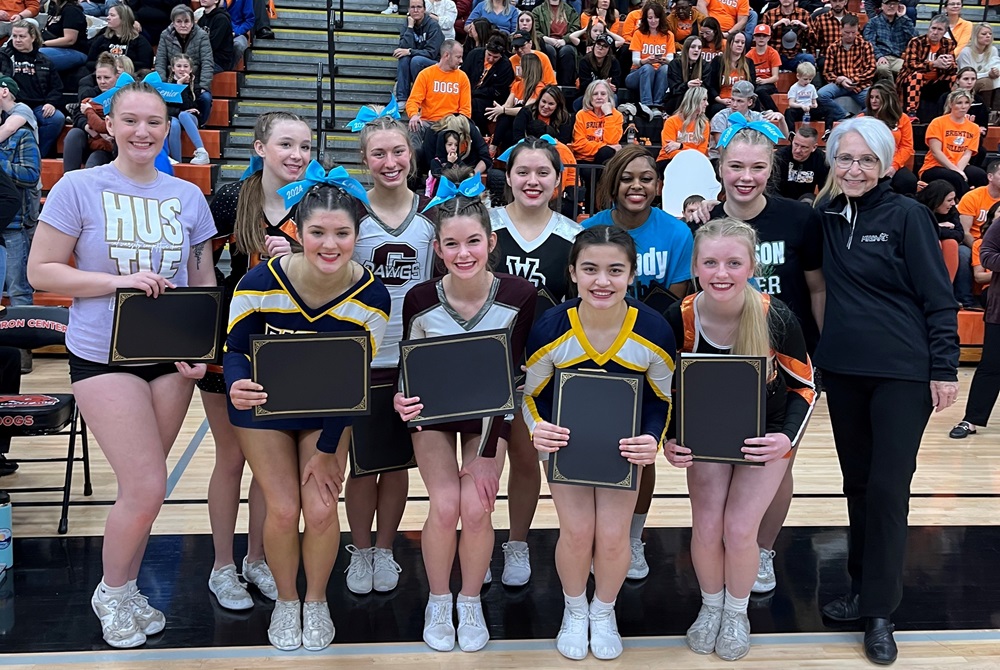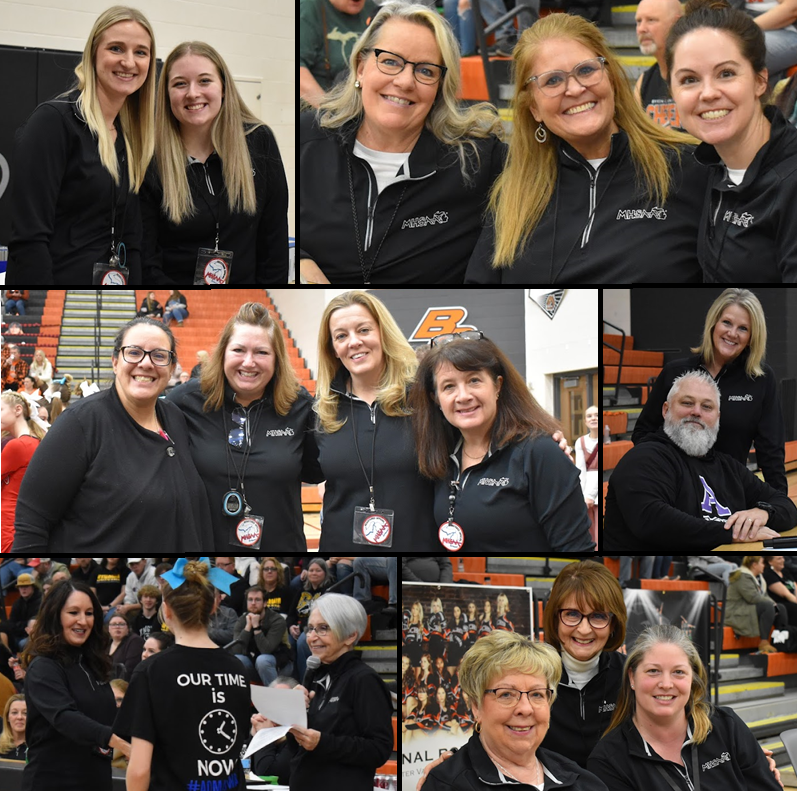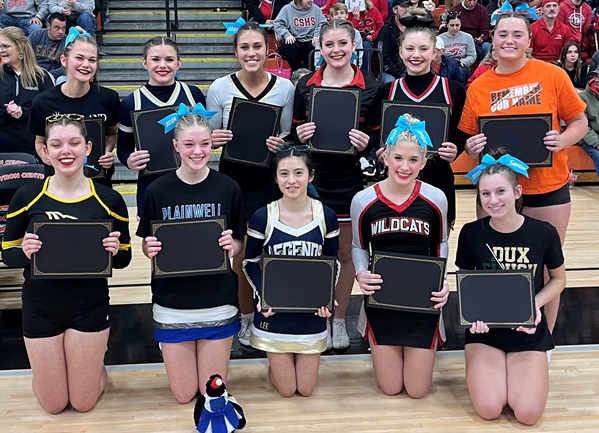
Several Officials Give Time, Talents to Grant $21,000 in Scholarships at 22nd LMCCOA Meet
By
Steve Vedder
Special for MHSAA.com
February 14, 2024
Jane Plaisted thinks it's one of those rare high school sporting events where scores and winners are secondary.
Instead, the focus of the recent Lake Michigan Competitive Cheer Officials Association meet is what the event could do for 75 seniors who competed in the sprawling 45-team meet at Byron Center.
All proceeds from the event went to fund scholarships for seniors who opted to write essays and then competed in the annual 22-year-old, three-division meet. The competition, which was completely run by LMCCOA judges, raised $21,000 to up its fundraising total to over $200,000 since the meet originated in 2001.
"It was a glorious day," said Plaisted, an LMCCOA member who has participated in 15 of the competitions. "The girls are happy, we're happy to give our time and it's such a positive day. We love being a part of it."
The event drew teams from as far away as St. Johns, DeWitt, Kalamazoo and Howard City Tri County. The chance to earn scholarship money was open to all 190 seniors who competed, and 75 chose to write an essay about "talking to their younger self and determining how competitive cheer has helped the athlete," said Stacy Smith, the president of the Michigan Cheer Judges Association. Smith said much of the event's dual goal is to promote competitive cheer while helping senior athletes wherever there is a financial need.
 The meet started with just five teams and a few hundred dollars in scholarships in 2001, but has blossomed into one of the largest single-day high school sports fundraisers in the state. The meet, which has been held at Byron Center three times as well as schools such as Caledonia and East Kentwood, reached a peak of raising $25,000 a year ago.
The meet started with just five teams and a few hundred dollars in scholarships in 2001, but has blossomed into one of the largest single-day high school sports fundraisers in the state. The meet, which has been held at Byron Center three times as well as schools such as Caledonia and East Kentwood, reached a peak of raising $25,000 a year ago.
What makes the day particularly special, Smith said, is that between 50 and 70 members of the LMCCOA annually show up to donate their time without knowing how their abilities will be put to use. In addition to judging the meet, members handle virtually every other aspect of the competition, from taking tickets, working the concession stand, filling water bottles, scoring, running a 50/50 raffle and whatever else organizers can find for them to do.
"Cheer athletes aren't always recognized a lot for their work, but it's a sport where (Michigan) colleges have gained notoriety at the national level and now offer scholarships," Smith said. "It's become a big deal in the state. Division I and II schools and NAIA schools all offer scholarships now. This can help."
Seniors who choose to participate write their essay prior to the meet, and then a committee of judges pore over the writings during the meet. Winners are announced following the competition. Twenty-one seniors were awarded scholarship money.
Smith said few parents probably grasp how much detail goes into running a long, grueling Saturday event.
"I'm not sure if people realize all the hands that have to make this happen," she said. "We've been doing it for 20 years, and for us it's like riding a bike. You never forget. It's just a wonderful day.
"I'm not surprised people want to be part of it and step up wherever they're needed."
Plaisted said judges sign up for jobs when they arrive at the meet. A judge can be officiating an event one minute and selling hot dogs moments later. The 'work wherever needed' attitude of judges, she said, is what makes the event a popular destination for participating schools.
"As officials, we emphasize young women participating," she said. "That old concept of the dumb blonde cheerleader doesn't exist anymore. This is an accomplished group of girls who we support. If you talk to any of (the judges), this meet is one of the most fun things we're going to do all season.
 "It's become so popular. We gave away like $50 the first year, and since then we've grown from one long day to two sessions so we could increase the number of teams. Everyone goes home with a smile on their face, which for officials doesn't always happen."
"It's become so popular. We gave away like $50 the first year, and since then we've grown from one long day to two sessions so we could increase the number of teams. Everyone goes home with a smile on their face, which for officials doesn't always happen."
Paw Paw cheer coach Stefanie Miller, whose team won the Division 3 portion of the meet, said coaches look forward to taking their teams to the meet.
"Absolutely because it's all about community," she said. "We talk to the girls about service and giving back. It's definitely a teachable moment, not only for the kids but for the adults, too, knowing what goes to the seniors."
"What I like best is that it promotes the athletes and all the work they put in. It's about giving back to them," added Brighton coach Christina Wilson, whose team won the Division 1 competition. "So many teams want to attend, and the coaches want the players to have a chance at a scholarship.
"I'm just in awe of seeing so many people there who are willing to give their energy for the kids."
One of Miller's favorite parts of the meet is watching fathers do a cheer "jump off" of their own tongue-in-cheek cheering skills while waiting for the final scores. She also loves volunteers making nearly 200 bows for participants to wear during the meet.
"Fathers do these cheerleader-type (routines) while there is a lull and it's just great," she said. "It's fun stuff like that that makes the day so special. It's all about giving back."
PHOTOS (Top) MHSAA official Jane Plaisted takes a photo with this year’s LMCCOA Division 1 scholarship winners. (Middle) Several officials contribute to making the meet an unforgettable experience. (Below) The LMCCOA also awarded scholarships to seniors from Division 2 and 3 schools. (Photos courtesy of Stacy Smith.)

Launching Pad and Destination
November 30, 2012
By Rob Kaminski
MHSAA benchmarks editor
Lamont Simpson’s “home” is a place he visits twice a week during his peak season, when NCAA Division I officiating duties have him navigating the Midwest like a person in a race for frequent flyer miles.
His travels pale in comparison to Stacey Thomas, who has lived in Latvia, Turkey and Sweden thanks to the game of basketball.
Then there’s Jim Garofalo, who authored his own cheat sheets to assist with the eight different rules books which intertwined during a period of time in his hockey officiating career, which included a trip to the Olympic Games.
So, naturally, there’s Simpson officiating an MHSAA Pre-District Football Playoff game in Detroit last fall, taking a postgame earful from a father who believed his son was the subject of a cheap shot during the game.
There’s Thomas, blowing a whistle with teenagers at the Healthy Kids Club in Detroit this summer
There’s Garofalo, ditching seven of the rules books over the last few years, and using only one now: the high school rules book.
It’s true that Simpson is at the pinnacle of his career, working Big Ten, Mid-American Conference and Horizon League men’s basketball, in addition to the WNBA in the summer, where he recently worked his eighth straight WNBA Finals.
And, yes, Thomas has her sights set on the NCAA Division I level and beyond, as her officiating career is still in its infancy.
Sure, Garofalo has achieved much on the ice both as an amateur and professional referee.
But, like so many in the officiating family, they deeply appreciate their roots and the people who helped them along the way. It’s a people business, first and foremost.
This week, continuing its "Making – and Answering – the Call" series, Second Half introduces Simpson, an officiating veteran of more than three decades. Profiles of Thomas and Garofalo will follow later this month.
It's about patience and honesty
The late June heat at the Kensington Valley Golf Course doesn’t seem to bother Lamont Simpson. The secret to his cool aura lies in his hand, a golf ball which he has identified as “Ref” in permanent marker.
Simpson is indeed a ref – permanently – thanks to a suggestion from Robert Menafee during the late 1970s, and the 1977 Detroit Redford grad has been most comfortable in the heat of competition’s spotlight ever since.
“I was at a football game at Henry Ford a year or two after high school, and Mr. Menafee, my former coach, saw me and asked what I was doing,” Simpson recalled. “He said I should try officiating. That’s the first I’d ever thought about it.”
It would be the impetus to a craft that has consumed nearly 30 years of Simpson’s life, as he now jets around the country as a top-flight NCAA Men’s Basketball official, and one of the senior officials in the WNBA, where he recently called his eighth consecutive Finals.
For all of his accomplishments, Simpson can still recall with great detail various moments that led to his current standing; mental snapshots which help to explain why he still registers as an MHSAA football official each year, and why he gives so freely of himself to anyone interested in getting a start in officiating.
“I still remember my first game, thinking, ‘I can’t believe I’m doing this,’” Simpson recalled. “In my second year I did a PSL (Detroit Public School League) playoff game, and to this day, walking into that gym is still one of my most gratifying times. There were about two or three thousand people in the stands, and I remember the butterflies.”
Fast forward to the Pontiac Silverdome in November 1992. In the waning seconds of the MHSAA Class A Football Final, a pigskin floats in the air doing its best butterfly imitation. Following a double-reverse pass, the tipped ball is finally corralled by Muskegon Reeths-Puffer’s Stacey Starr at the 10-yard line and carried into the end zone to give his school a 21-18 win over Walled Lake Western in one of the most frenzied finishes in MHSAA Finals history.
Simpson had a good view of the moment.
“I was the back judge, working my first MHSAA Final. My first thought is to get in position and then, ‘Oh man, the ball is tipped,’” Simpson replays in his mind. “You’re part of a game-ending situation and you don’t want to screw it up. You almost become a fan in a game like that—a moment like that—but you’ve got your job to do. Afterward, when it was all over, I just remember thinking, ‘What a football game I got to be a part of.’”
 Simpson would also get a shot as a Football Final referee in 2003, and worked the 1995 Boys Basketball Final which featured Flint Northern’s team led by future MSU Spartans Mateen Cleaves and Antonio Smith. But, Simpson remembers that game for a different reason.
Simpson would also get a shot as a Football Final referee in 2003, and worked the 1995 Boys Basketball Final which featured Flint Northern’s team led by future MSU Spartans Mateen Cleaves and Antonio Smith. But, Simpson remembers that game for a different reason.
“It was the last time that the Final was worked with a two-person crew.” Simpson said. “I remember the great athletes in the game, and being part of history as the last two-man crew in the Finals is something to be proud of.”
Simpson is quick to point out, however, that simply having what it takes to officiate an athletic event at any level is something of which to be most proud. While it’s natural for new officials to covet championship assignments and careers beyond the high school level, Simpson stresses patience, hard work, and – in many cases – honesty with one’s own performance as the most valuable traits an official can possess.
“I work and speak at a lot of camps, and I stress that people need to work at the craft – mechanics, rules, physical appearance – and above all have patience.” Simpson said. “The thing I see in younger officials now that is so different than when I was coming in, is they don’t have the patience; they don’t want to pay their dues.”
Sometimes, even the greatest amount of patience, perseverance and hard work isn’t enough. And, that’s where honesty in self-evaluation comes in. Yes, there are egos in officiating. To some extent, it’s a prerequisite. However, humility can also lead to finding a niche in the game.
Simpson himself is an example.
“My goal was to work in the NBA, but after seven years in the CBA, I realized that it probably wasn’t going to happen,” he said. “But, you know, there was still a lot of good basketball out there to work. When I left the CBA, I did so on my own terms, and went to work on my college career. So, sometimes you weigh your options and focus on the next goal.
“The point is, work at being the best at whatever level you work. I’ve seen guys spend a lot of money at the same camps year after year, and never get that college assignment,” Simpson said. “Maybe it’s time for them to focus on a different level.”
In that respect, the very thing that drives officials and gets them in the game in the first place can by the very thing that drives them out. Passion and drive, the need to reach the next level, can keep people focused in their chosen quest; the frustration of not advancing can also lead to their exit.
True, Simpson is one of 32 officials in the WNBA, and just worked his eighth WNBA Final. He has a full NCAA Division I men’s basketball schedule. But, the father of three grown children and grandfather of five cannot express enough the fringe benefits that officiating brings at any level.
“You become a better people person through officiating. Your communication skills are sharper,” he says. “Not only what to say and when to say it, but you learn to listen. You have to be a listener in this business, and that’s a great skill to have in life.”
It also provides the opportunity to be a teacher and recruiter. It’s one of the reasons he’s closing in on nearly three decades as an MHSAA registered official. What better way to pass the knowledge forward?
“No matter where you end up, always remember where you started, and keep your friends,” Simpson said. “I return every call, every text. I still talk to the same guys I grew up with. From an officiating standpoint if we could all just bring along one person at a time, think of the effect that would have.”
Simpson does more than his share, from speaking at camps and clinics – all voluntarily, mind you – to the behind the scenes recruitment, such as the time he surrendered all of his baseball umpiring equipment to a friend under the condition that person register with the MHSAA and begin working games.
He thinks back to the suggestion from Coach Menafee frequently. “Oh, all the time,” Simpson said. “I think of the places I’ve been, the things I’ve seen, the people I’ve met and the person I’ve become. This is what being an official does.”
There’s a scenario that Simpson replays time and again when he talks of officiating, and it doesn’t pertain to his collegiate or professional experience. In fact, it’s not even about basketball.
“It’s Friday night, and you’re working the big rivalry game between two communities. You get on the field, the bleachers are packed, the bands are playing, and you’re right in the mix,” Simpson says with reverence. “That’s it right there. It doesn’t get much better than that. That’s it.”
PHOTO: Lamont Simpson officiates WNBA games during the summers, including this contest involving the Atlanta Dream and player Erika de Souza (14).
NOTE: This is the fifth installment in the series "Making – and Answering – the Call" detailing the careers and service of MHSAA officials. Click the links below to view the others.

